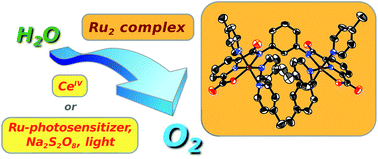Catalyst–solvent interactions in a dinuclear Ru-based water oxidation catalyst†
Abstract
Photocatalytic water oxidation represents a key process in conversion of solar energy into fuels and can be facilitated by the use of molecular transition metal-based catalysts. A novel straightforward approach for covalent linking of the catalytic units to other moieties is demonstrated by preparation of a dinuclear complex containing two [Ru(pdc)(pic)3]-derived units (pdc = 2,6-pyridinedicarboxylate, pic = 4-picoline). The activity of this complex towards chemical and photochemical oxidation of water was evaluated and a detailed insight is given into the interactions between the catalyst and acetonitrile, a common co-solvent employed to increase solubility of water oxidation catalysts. The solvent-induced transformations were studied by electrochemical and spectroscopic techniques and the relevant quantitative parameters were extracted.



 Please wait while we load your content...
Please wait while we load your content...